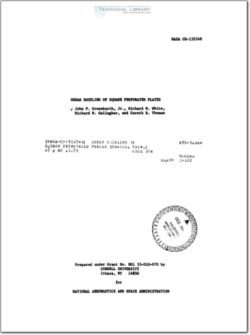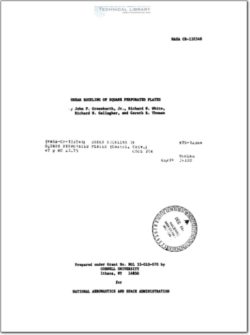NASA-CR-132548

- Version
- 837 Downloads
- 10.86 MB File Size
- 1 File Count
- November 27, 2015 Create Date
- November 27, 2015 Last Updated
Shear Buckling Of Plates With Holes

ABSTRACT
The behavior of thin square perforated plates under
the action of uniform shear deformation is studied experi-
mentally and analytically using finite element analysis.
Elastic Shear buckling strength is established as a function
of the diameter of a round, centrally located hole in the
plate. Post buckling behavior and the behavior of perfor-
ated plates with various ring stiffeners are also studied
experimentally.
Key Words
Shear buckling
Plate buckling
Centrally located circular perforations in plates
Finite element analysis
Experimental study
Reinforcement
1. INTRODUCTION
Thin plates occur in a wide variety of structures.
While a good deal of our early knowledge about the behavior
of thin plates has evolved from research directed to civil
engineering structures such as plate girders, new applica—
tions in aerospace structures and pressure vessels have ac-
celerated research in recent years.
Whatever the application, plate elements often block
access to some other portion of the parent structure. Per-
forations are made in plates to allow permanent passage of
electrical, hydraulic, or other conduits, or simply to per—
mit easy access for painting or servicing. Where a reduc-
tion in strength is permissible, a hole might be placed in
a plate to reduce weight. This is common in aerospace
structures. In some cases, the reduction in the strength
of the plate can be offset by the presence of a stiffener.
Plate elements are often subjected to complex loading
conditions. To understand the behavior of perforated plates
under complex loads, we must first know something of their
behavior under more simple loading conditions. The behavior
of thin, square, perforated plates subjected to in—plane
shear is studied experimentally and analytically in this
report. The plates have clamped edges and centrally located,
circular perforations. An experimental study of stiffened
perforated plates is also presented here.
A key aspect in the behavior of any thin plate is its
buckling strength. Thin plates commonly become unstable
at stress levels far below the proportional limit of the
material. In some cases, the large transve"Se deformations
associated with buckling can be tolerated an: only the ulti—
mate strength of the plate is of any practical consequence.
Elsewhere, aerodynamic or aeschetic considerations dictate
that buckling cannot be allowed.
| File | Action |
|---|---|
| NASA-CR-132548-shear-buckling-of-plates-with-holes.pdf | Download |
